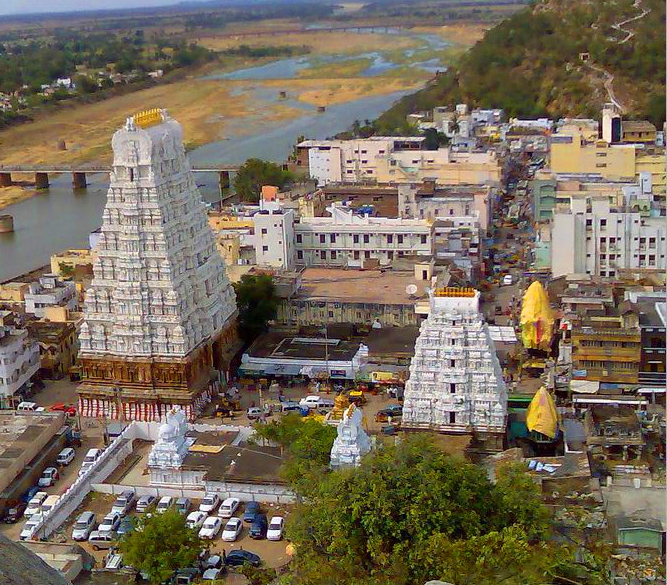Kallahasti Sri Kalahastheeswarar Temple (Air)- Andhra Pradesh

Address
Kallahasti Sri Kalahastheeswarar Temple (Air), Kallahasti, Chittoor District – Andhra Pradesh State- – Post – 517 644
Diety
Kalathi appar, Amman: Gnana prasunambika
Introduction
Srikalahasti Temple is located in the town of Srikalahasti, in the state of Andhra Pradesh, India. It is one of the most famous Shiva temples in South India, and is said to be the site where Kannappa was ready to offer both his eyes to cover blood flowing from the Siva linga before the Siva stopped him and granted him moksha. Srikalahasti temple, situated 36 km away from Tirupati is famous for its Vayu linga, one of the Panchabhoota Sthalams, representing wind. The temple is also regarded as Rahu-Ketu kshetra and Dakshina Kailasam. The inner temple was constructed around 5th century and the outer temple was constructed in the 11th century by the Rajendra Chola I, later Chola kings and the Vijayanagara kings. Shiva in his aspect as Vayu is worshiped as Kalahasteeswara.
Puranic Significance
Around the 11th century, the Chola king Rajendra Chola I king renovated the temple and constructed the main structure.The temple received contributions from various ruling dynasties like Chola Dynasty and Vijayanagar Empire. The hundred pillared hall with intricate carvings was commissioned during the regime of Krishnadeva Raya during 1516 AD.The presiding deity of the temple Gnana Prasunambika Devi was born in Vellathurar Gotra of Senguntha Kaikolar. Customary for the bride to bring home the dowry and submit it by these Vellathurar peoples at the Shiva Parvati wedding held here. During the early days of creation, Vayu performed penance for thousands of years to “Karpoora lingam” (Karpooram means camphor). Pleased with his penance, Shiva manifested before him and said, ” O Vayu Deva! Though you are dynamic in nature, you stayed here without movement and did penance for me. I’m pleased with your devotion. I shall grant you three boons”. Vayu said, “Swami! I want to be present everywhere in this world. I want to be an integral part of every Jiva who is none other than the manifestation of Paramatma. I want to name this Karpoora Linga, which represents you, after me. Samba Siva said,” Your are qualified for these three boons. As per your wish, you will be spread throughout this world. Without you there will be no life. This linga of mine will forever be known all over through your name, and all Suras, Asuras, Garuda, Gaandharvas, Kinneras, kimpurushas, Siddhas, Saadhvis, humans and others will worship this Lingam”. Shiva disappeared after granting these boons. Thereafter, this Karpoora Vayu Lingam is worshipped by all Lokas (worlds).[3] There are several other legends connected to the glory of the temple. Prominent among them is of Parvati who was cursed by Shiva to discard her heavenly body and assume the human form. To get rid of the above curse Parvati did a long penance here. Pleased with her deep devotion Shiva again recreated her body – a hundred times better than her previous heavenly body and initiated various mantras including the Panchakshari. Consequent to this, Parvati gained fame and came to be known as Shiva-Gnanam Gnana Prasunamba or Gnana Prasunambika Devi. Cursed to become a ghost, Ghanakala prayed at Srikalahasti for 15 years and after chanting the Bhairava Mantra many times Shiva restored her original form. Mayura, Chandra and Devendra were also freed from their curses after taking bath in the river Swarnamukhi and praying at Srikalahasti. To Bhakta Markandeya, Shiva appeared in Srikalahasti and preached that a Guru alone could make esoteric teachings and, therefore he is Brahma, Vishnu and Maheswara. As per another legend, Vayu and Adishesha had a dispute to find out who is superior, to prove the superiority Adishesha encircled the Kailasam, Vayu tried to remove this encircle by creating Twister. Because of the twister, 8 parts from kailasam fell into 8 different places which are Trincomalee, Srikalahasti, Thiruchiramalai, Thiruenkoimalai, Rajathagiri, Neerthagiri, Ratnagiri, and Suwethagiri Thirupangeeli.
Beliefs
This temple is famous for Rahu-Kethu pooja. It is believed that performing this pooja will ward the people from astrological effects of Rahu and Kethu.As per Hindu legend, Kalahatiswara was worshipped at this place by Brahma during all four Yugas. Arjuna, the Pandava prince during Mahabharata is believed to have worshipped the presiding deity. The legend of Kannappa, who was a hunter and turned into an ardent devotee of Shiva accidentally, is associated with the temple. The temple also finds mention in the works of Nakeerar and the Nalvars, namely, Appar, Sundarar, Sambandar and Manickavasagar in the canonical works of Tirumura.
Special Features
The temple was built by Rajendra Chola I, The 120 feet (37 m) high main gopuram and the 100 pillar mandapam were constructed by Krishnadevaraya, the Vijayanagara king in 1516. The presiding image of Shiva in the form of Linga is made of white stone in a shape resembling trunk of elephant. The temple faces south, while the sanctum faces west. The temple is located on the foothills of a hill, while there is also a belief that the temple was carved out of a monolithic hill. There is a rock cut shrine of Vinayaka, 9 ft (2.7 m) below the ground level. Vallaba Ganapathi, Mahalakshmi-Ganpathi and Sahasra Lingeswara are some of the rare images found in the temple. There is a large shrine of Jnanaprasanammba, the consort of Kalahatisvara. There are smaller shrines in the temple for Kasi Viswanatha, Annapurna, Suryanarayana, Sadyoganapathi and Subramanya. There are two large halls namely Sadyogi Mandapa and Jalkoti Mandapa. There are two water bodies associated with the namely, Surya Pushkarani and Chandra Pushkarani.
Festivals
On the key festivals celebrated at the temple is Mahashivaratri which occurs in the Maasi month which occurs from 15th February to 15thMarch. The fifth day of the Massi month coincides with Mahashivaratri. During the celebration of the festival the pooja of the deities are performed with zeal and enthusiasm.
Century/Period/Age
1000-2000 years
Managed By
Hindu Religious and Charitable Endowments (HRCE)
Nearest Bus Station
Kallahasti
Nearest Railway Station
Chittoor Station
Nearest Airport
Tirupati





